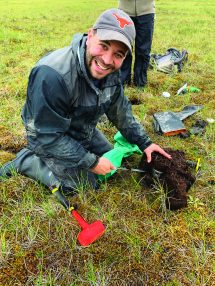Patterns in Permafrost Soils Could Help Climate Change Models
November 12, 2020

The Arctic covers about 20% of the planet. But almost everything hydrologists know about the carbon-rich soils blanketing its permafrost comes from very few measurements taken just feet from Alaska’s Dalton Highway.
The small sample size is a problem, particularly for scientists studying the role of Arctic hydrology on climate change. Permafrost soils hold vast amounts of carbon that could turn into greenhouse gasses. But the lack of data makes it difficult to predict what will happen to water and carbon as the permafrost melts due to warming temperatures.
New research led by the Department of Geological Sciences may help solve that problem.
Scientists spent four summers measuring permafrost soils across a 5,000-square-mile swath of Alaska’s North Slope, an area about the size of Connecticut. While they worked to build up a much-needed soil data set, their measurements revealed an important pattern: The hydrologic properties of different permafrost soil types are very consistent and can be predicted based on the surrounding landscape.
“There is a vast swath of land that is eminently predictable,” said Michael O’Connor, who led the research while earning a doctoral degree at the Jackson School of Geosciences. “Our paper shows that over an enormous study area, these very simple patterns in these properties hold true.”
The study was published June 4, 2020, in the journal Geophysical Research Letters. Co-authors include researchers from the Jackson School, UT’s Cockrell School of Engineering, Utah State University and the University of Michigan.
The researchers examined nearly 300 soil samples from different types of terrain. They found that soil types and their thickness are closely associated with the landscape, with the researchers classifying the landscapes into five categories based on the dominant vegetation and whether the environment was on a hill slope or near the bottom of a river valley.
They also found that each of the three soil types had distinct properties that affected how easily the soil could transfer heat and water — which determine how carbon dioxide and methane, another powerful greenhouse gas, are released. The findings will allow scientists to look to the landscape to understand how carbon and greenhouse gases are moving through the soil below. Although the study does not make predictions about carbon release, coauthor and Jackson School Professor Bayani Cardenas said that it provides a research framework.
“Our data fills a knowledge gap that has been around for 30 years,” Cardenas said. “The community studying permafrost and climate change will appreciate its inherent value.”
Back to the Newsletter